58 years after Burt Munro’s iconic land speed record, Indian Motorcycle returned to the Bonneville Salt Flats with an Indian Challenger plucked from their King of the Baggers stable. Here’s how they did it.
Indian Motorcycle’s racing roots run deep. From Ed ‘Iron Man’ Kretz’s 1937 Daytona 200 win and the original Wrecking Crew’s dominance to Jared Mees’ modern flat track supremacy, the marque has powered champions across generations. And then there’s Burt Munro, the Kiwi folk hero who, in 1967, smashed the under-1000 cc land speed record on a shed-built 1920 Scout.
These days, Indian’s focus is squarely on the spectacle of bagger racing. Linking their modern program to their storied past, they’ve just set a new 2000 cc land speed record at Bonneville aboard a modified racing-spec Indian Challenger. Here’s a look at what it takes to build the world’s fastest Indian bagger.
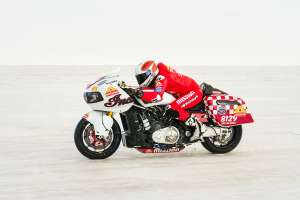
Working with their title sponsor in the King of The Baggers (KOTB) series, S&S Cycle, Indian based their Bonneville contender on their ‘regular’ Indian Challenger race bike. The KOTB-spec Challenger uses the 112 ci version of Indian’s PowerPlus V-twin motor, which, in stock form, is good for 126 hp.
Neither Indian nor S&S Cycle has published an official spec sheet for their 2025 bike. Still, we know that previous iterations have boasted proprietary mods like big-bore pistons, CNC-ported heads, upgraded cams and adjustable rocker arms, and a highly-tuned MaxxECU ECM. So it’s safe to assume that the current engine is as hopped-up as it gets.
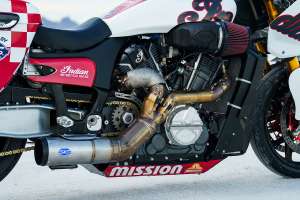
S&S Cycle pushed the Challenger’s engine even further on this particular build. Since high-octane fuel can be used at Bonneville, they ran a higher compression ratio to eke out a few more horses. They also swapped the lightened crankshaft from the KOTB spec for a full-weight one.
The crew carried over the KOTB bike’s 78 mm intake—a purpose-built design from S&S that uses various forms of 3D printing to allow for complex shapes and high quality. Ground clearance is less of an issue when you’re blasting along the salt flats in a straight line, which left S&S free to fabricate a burly exhaust that prioritizes flow over volume.
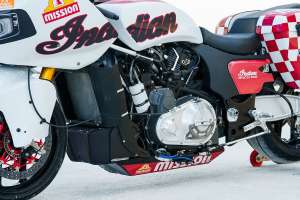
Indian and S&S dove into the KOTB parts bin for their Bonneville bike’s running gear. The suspension is from Öhlins, but it’s been lowered to tailor the bike to speed runs. The forged wheels are Indian’s standard race-spec, built by PVM in Germany, and are wrapped in Dunlop Dragmax tires.
One notable deviation is the Challenger’s swingarm. Originally designed by S&S last year, it turned out to be a better fit for Indian’s land speeder than the current KOTB part.
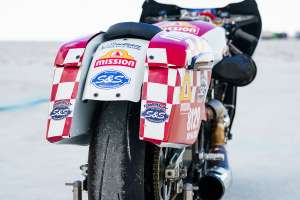
At a glance, the Bonneville Challenger’s bodywork looks near-identical to the bagger race bike’s—but it sports several subtle mods. The fairing was narrowed and fitted with a different windscreen, the front fender gained more meat, and the tank was modified to align with the class specifications and to create a tighter riding position.
Out back, the Challenger’s track-spec seat was traded for a deeply scooped saddle, and its cases were cut open, narrowed, and put back together to create a narrower profile. Cases on a land speed bike might seem silly, but Indian tells us that the whole idea was to see how a bagger would fare on the salt—and a bagger needs cases.
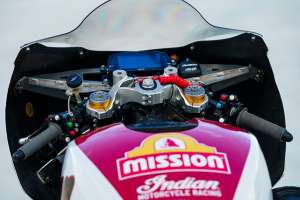
The rider triangle was tweaked further by fitting lower clip-ons and pushing the foot pegs further back. The land-speeder’s cockpit uses the same AIM dash and data-logging system as its KOTB counterpart, but the braking system is wildly different. The crew removed the front brake lever and calipers, and installed a bar-mounted thumb lever with a Beringer master cylinder to trigger the rear brake.
Buttons on the left-hand side of the bars control the bike’s air-shift system. The brake and shift systems negate the need for the rider to grab at levers or move their feet, so that they can remain perfectly tucked at all times.
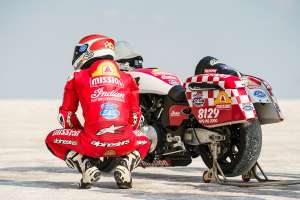
The final change is the Bonneville bike’s fresh livery. Regular Indian KOTB sponsor Mission Foods stepped up as the land speed project’s main sponsor, so the team honored them with a design that took inspiration from the Mission Foods race cars, tweaking it to feature Indian and S&S Cycle’s branding.
With Indian Wrecking Crew racer and two-time KOTB champion Tyler O’Hara in the pilot’s seat, Indian’s Bonneville-spec Challenger blazed across the salt to set a new AMA 2000 cc APS-AG record of 194.384 mph. O’Hara shattered J.Angerer’s five-decades-old class record of 169.828 mph, set aboard a Triumph in 1972.
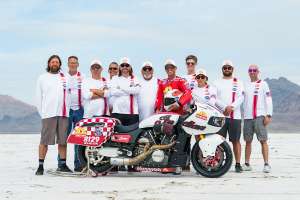
The gap between O’Hara’s new time and Munro’s 1967 record is notably smaller; O’Hara went just over 10 mph faster, on a bike that was built 105 years after Munro’s and with twice the engine size. (Those who were there will tell you that Munro went even faster, with an unofficial speed north of 205 mph.)
“Bonneville is hallowed ground,” says Gary Gray, VP of Indian Motorcycle’s racing department. “While we’re proud to have broken a record, this effort was about more than setting a land speed mark—it was about honoring the legends who came before us and pushing ourselves to go as fast as we could.”
Source: Indian Motorcycle